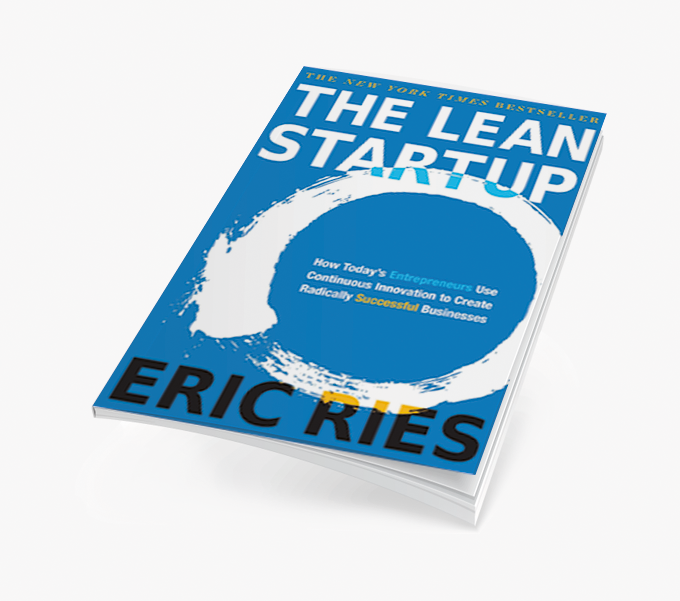

from Eric Ries
In "The Lean Startup," Eric Ries revolutionizes entrepreneurial strategy with concepts like Minimum Viable Product, Build-Measure-Learn, and validated learning. Emphasizing rapid prototyping, iterative design, and adaptability, the book guides startups in responding to customer feedback and market adaptation. It is a cornerstone for innovation, pivotal for leadership in startups, and reshaping startup culture.
“We must learn what customers really want, not what they say they want or what we think they should want.” – Eric Ries, The Lean Startup
BRIEF BOOK SUMMARY
"The Lean Startup" by Eric Ries revolutionizes the approach to business startups, advocating for a methodology that emphasizes adaptability, customer feedback, and iterative design. Rooted in principles of lean manufacturing, it challenges traditional business models by prioritizing learning and flexibility over rigid planning and forecasting.
At the heart of the Lean Startup methodology is the Build-Measure-Learn feedback loop. Startups are encouraged to develop Minimum Viable Products (MVPs) – the simplest version of a product that can be launched to test market hypotheses. This approach allows for rapid prototyping and immediate customer feedback, enabling startups to adapt and evolve quickly. Instead of extensive product development based on assumptions, the MVP method focuses on actual customer needs and behaviors.
The concept of validated learning is central to the Lean Startup. It emphasizes that the success of a startup is measured not by traditional metrics like sales and revenue, but by how much has been learned about customer needs and behaviors. This approach requires a shift in mindset: viewing products as experiments, embracing failures as learning opportunities, and continuously testing and tweaking the product based on customer interactions and feedback.
Ries extends the definition of entrepreneurship beyond startups, applying Lean principles to all levels of an organization. He argues for a leadership style that supports a culture of experimentation and learning, where innovative thinking is encouraged, and failures are viewed as opportunities for growth.
The book also introduces the concept of sustainable growth, achieved through one of three engines of growth: the sticky engine (customer retention), the viral engine (customer referrals), and the paid engine (customer acquisition through paid channels). Each engine has distinct metrics and strategies, underscoring the need for startups to choose the right growth strategy based on their specific market and product.
"The Lean Startup" is not just about startup methodology; it’s a blueprint for managing any organization in a complex and uncertain environment. It is a call to shift from traditional business planning to a more flexible, learning-oriented approach. This methodology applies to a wide range of organizations and industries, emphasizing the importance of innovation, adaptability, and customer-centric design in today’s rapidly evolving business landscape.
In essence, "The Lean Startup" presents a new paradigm for building and growing businesses, offering valuable insights and practical strategies for entrepreneurs, business leaders, and innovators seeking to thrive in the modern world of continuous change and uncertainty
WHY SHOULD YOU READ THIS BOOK? By Francisco Santolo
Eric Ries gained worldwide recognition for this book, which has sparked the formation of entrepreneurial communities around the world and feeds their practices today. "The Lean Startup" method described in this work combines the Customer Development methodology, introduced by Steve Blank and his co-author Bob Dorf in "The Startup Owner's Manual," with the principles of agile methodologies, designed for the optimization of software development and inspired by production, specifically the Toyota Production System (TPS), launched in 2001.
Due to this unique and powerful integration, Lean Startup ensured that agile frameworks, by then already popularized among top-level developers, gained validity and application from a business perspective as well. The tightly integrated and collaborative technology community facilitated the viral spread of these tools, which, paradoxically, only later caught the interest of the business community. However, despite its widespread popularity, there is still a deep lack of understanding of the agile values and principles and the correct way to apply Lean Startup in both "successful" startups, which have raised tens of millions of dollars in investment rounds, and established corporations.
The effectiveness of agile values and principles, and their practical application tools, depends on their vigorous integration with Steve Blank's Customer Development philosophy and method, which provides the vision and business strategy. Identifying and highlighting this necessary synergy is Eric Ries's great merit. Technology per se does not add value. It must enhance a business model that adds value to all actors, fundamentally to the customer, by solving a problem need, or desire.
Key in "The Lean Startup" is the concept of the Minimum Viable Product (MVP). The book delves deep, advocating for validated learning while discarding vanity metrics, conventional business plans, and traditional assumptions. Ries urges us to prioritize learning, using empirical data and customer interaction over speculation. The correct use of these concepts and tools breaks down business and productivity paradigms believed to be solid. Its acquisition and implementation also bring order to the task of entrepreneurship, previously a completely intuitive art.
The emphasis on continuous innovation resonates with the contemporary need for constant adaptation and improvement. The book brilliantly articulates the balance between having a strong vision and being receptive to customer feedback – a crucial balance for creating visionary products and services that are relevant to the market. "The Lean Startup" is more than a methodology; it offers a change in mindset and paradigms. Its principles, along with Steve Blank's Customer Development methodology, provide a comprehensive framework for entrepreneurs and business leaders for the businesses of the future.
Francisco Santolo
WHY SHOULD YOU READ THIS BOOK? By Francisco Santolo
The Startup Owner's Manual: The Step-By-Step Guide for Building a Great Company by Steve Blank and Bob Dorf
This book is an essential guide for any startup entrepreneur. It is the precursor to "The Lean Startup" by providing the step-by-step methodology for building new ventures, the customer development methodology. While "The Lean Startup" offers the philosophy and overarching strategy of the lean methodology, "The Startup Owner's Manual" delves into the specific steps and tactics required to implement these strategies, making it an indispensable guide for applying the concepts discussed in "The Lean Startup."
Value Proposition Design: How to Create Products and Services Customers Want by Alexander Osterwalder, Yves Pigneur, Gregory Bernarda, Alan Smith, and Trish Papadakos
"Value Proposition Design" complements "The Lean Startup" by focusing on one of its core elements: creating value for customers. This book offers practical tools and templates to help entrepreneurs design, test, and deliver what customers actually want. It expands upon the idea of validated learning and customer feedback from "The Lean Startup" and provides a detailed framework for understanding customer needs and designing products and services that meet those needs effectively.
Running Lean: Iterate from Plan A to a Plan That Works by Ash Maurya"Running Lean" is a perfect companion to "The Lean Startup" as it delves deeper into the Lean methodology, particularly in the context of creating a lean business plan. Maurya offers actionable steps for iterating a startup based on customer feedback, closely mirroring Ries' Build-Measure-Learn feedback loop. This book complements "The Lean Startup" by providing more detailed strategies and tools for applying Lean Startup principles.








